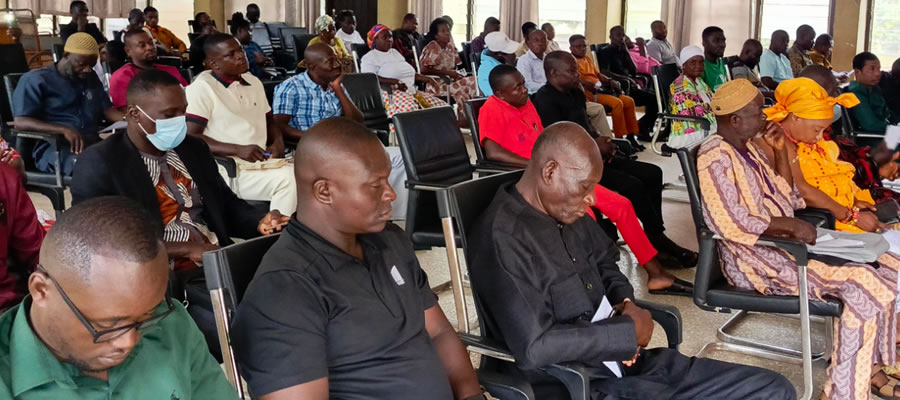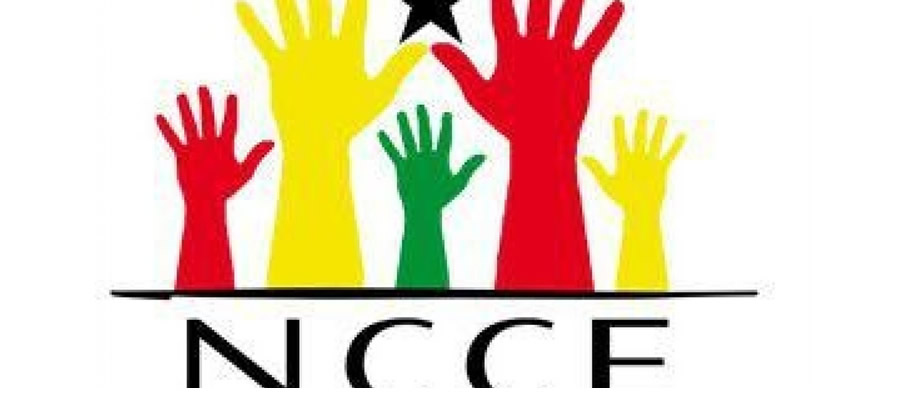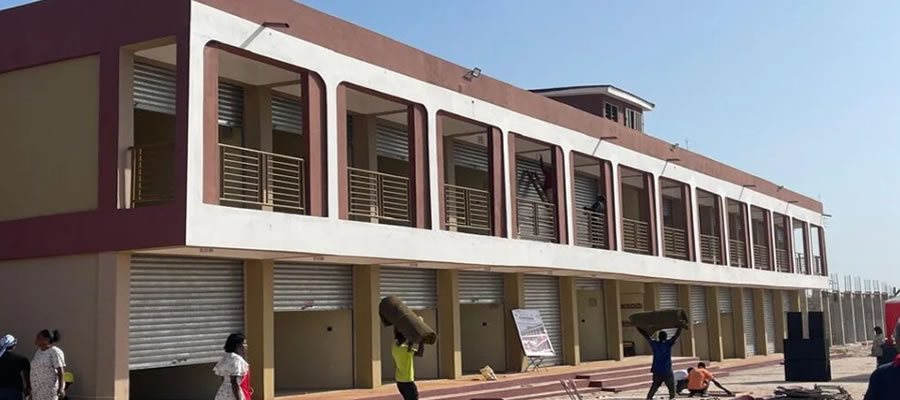

Goals and Objectives
The Municipal Development plan has been formulated in line with the GPRS II themes as well as the Government’s priority areas as contained in the Growth and Poverty Reduction Strategy (2006-2009). This is to ensure that efforts are harmonized at all levels – Municipality, Regional and National. The peculiarities of the Municipality were however, taken into consideration.
Municipal Development Focus
The overall goal of the medium term plan which has been set within the framework of the GPRS II is to expand the capacity for sustainable and equitable growth as well as create wealth within an environment that empowers all stakeholders irrespective of their social economic status to fully participate in the development of the Municipality.
This indicates the areas, where the Municipality would intensively concentrate its effort and resources within the priorities and prospects for development, over the plan period. The plan also takes into consideration all on-going projects as well as projects which serve as pre-requisites for the implementation of long-term projects. Within this context, the medium term programme focuses on the following components of development.
Private Sector- Led Competitiveness
Human Development and Basic Services
Good Governance and Civic Responsibility.
Programme Components
1. Private Sector –Led Competitiveness:
This component seeks to ensure a sound and conducive environment for competitive private sector activities to promote growth and poverty reduction.
The components of the programme include the following:
- Harness the potential of the informal sector to promote poverty reduction.
- Promote technical/vocational based training institutes to support informal sector.
- Increase and sustain employment opportunities focusing on the informal sector, private sector, youth, women and the disabled.
- Ensure the provision, expansion and maintenance of transportation infrastructure of all kinds.
- Facilitate the provision of affordable transport system.
- Enhance the development of I. C. T. infrastructure.
- Promote the development of E-Strategies in key sectors of the local economy especially in agriculture and governance.
- Promote the use of I.C.T. in education.
- Promotion of tourism as a major source of local revenue and employment generation and in such a way to preserve the Bono Culture and the environment.
- Facilitate development of a light industrial zone.
Agric objectives
- To facilitate the acquisition of land and security of land tenancy in the municipality.
- To promote six (6) water and soil management strategies in twenty-five (25) operational areas by the end of 2009.
- To introduce improved crop production of techniques to farmers in twenty-five operational areas by the year 2009.
- To promote proper handling and use of agro-chemicals and introduce IPM principles in ten (10) major vegetable producing areas areas in the municipality by 2009.
- To promote non-traditional commodities production in twenty-five (25) operational areas by 2009.
- To facilitate and promote agric mechanization.
- To improve the production of livestock by the year 2009.
- Promote the construction and use of improved local storage structures and standard silos.
- Enhance access to market and other vital agricultural issues by traders, farmers and others by the end of 2009.
- To introduce 750 farmers to improved animal production techniques by end of 2009.
- To promote improved animal health care by 30% in the municipality by the end of 2009.
- To promote aqua-culture in 15 operational areas by the end of 2009.
- To ensure strong networking between stakeholders on food security issues.
Strategies
- Promote land reforms that ensure equal access for men, women and persons with disability.
- Rehabilitate and promote the use of irrigation infrastructure.
- Expand irrigation infrastructure.
- Promote the establishment of agro-business and industrial zones and land banks.
- Promote environmentally sustainable cropping practices in agro forestry, land and water management in farming communities.
- Promote and expand the production of selected crops including cashew, mango, soya beans among others.
- Provide improved breeds and small ruminants.
- Improve animal husbandry practices.
- Intensify disease control surveillance.
- Ensure easy and affordable access to tractor services to both men and women farmers.
- Provision of storage and processing equipment.
- Improve access to affordable credit to women and men.
- Facilitate the establishment of agro processing industry for export.
- Promote the establishment of storage facilities including community level facilities.
- Promotion of community based extension agents.
- Ensure the creation of data base on employment.
- Promote skills training.
- Promote youth employment.
- Promote the training and employment of people with disability and women.
- Maintain and expand feeder roads.
- Construction of culverts.
- Construction and rehabilitation of access roads in urban centres.
- Promote the use of intermediate means of transport.
- Facilitate expansion in access to telephone.
- Implement national E-governance Programme.
- Facilitate the provision of internet access to model senior secondary schools and other selected schools.
- Facilitate establishment of agric information centre.
- Market Techiman as a competitive tourist destination.
- Enhance tourist services and standards
- Develop and sustain eco-tourism and culture sites.
- Prepare strategic municipal tourism plan.
- Facilitate improvement and expansion in the capacity of hospitality services.
- Build capacities of community with tourist sites for service delivery.
- Facilitate the promotion of sports.
- Facilitate the floating of Municipal Bonds
Human Development and Basic Services
Goal
To build the human capacity of the Municipality for self sustained development, as well as ensure enhanced social services.
Education
Goal: Strengthening and improving educational planning and management.
Objectives
- Ensure effective decentralization and community ownership and participation.
- Provide and ensure access to free basic education.
- Strengthen monitoring and Evaluation and Accountability systems across the whole sector.
- Promote Science, Mathematics and Technical Education and Training.
- Improve quality of teaching for enhanced pupils/students performance.
- Promote gender equity in enrolment and retention.
- Development a motivated teaching cadre for all levels with support from the private sector, CBOs, NGOs, FBOs and Development Partners.
- Provide school and public facilities and encourage community/private libraries.
- Provide Pre-School Education in collaboration with MA, Private Sector, CBOs, NGOs and FBOs.
- Provide infrastructure and encourage the private sector, CBOs, NGOs and Development Partners to participate
Strategies
- Expand pre-school access in all basic schools.
- Increase school enrolment.
- Rehabilitation and development of basic school infrastructure (with water and toilet facilities).
- Provide scholarship for brilliant but needy students especially the girl child.
- Expand non-formal education in partnership with community groups, NGOs and Private providers.
- Facilitate the implementation of capitation grant in all public primary schools.
- Facilitate the implementation of school feeding Programme in selected public schools.
- Promote entrepreneurship among the youth.
- Sensitize parents and communities about importance of girl’s education.
- Provide incentives to teachers in deprive areas.
- Identify and promote programmes that will assist in the prevention and management of HIV/AIDS/STDs.
- Promote civic education and conflict prevention.
- Train unemployed youth on competency based demand driven skills including the STEP Programme.
Child Labour
Objective
Strengthening the technical and logistical capacity of relevant of relevant district agencies dealing with Child Labour issues.
Strategies
• Institutional capacity building.
• Awareness creation on the effects of Child Labour.
• Law enforcement on issues concerning Child Labour.
Health
Objectives
- Provide residential accommodation for staff from October 2006 to December 2009.
- Rehabilitation of old MHD office into Polyclinic.
- Construction of culverts.
- Completion of CHPS compound.
- To reduce the incidence of malaria from 38% to 36% by December 2009.
- To reduce the incidence of HIV/AIDS from 2% to 1.5% by December 2009.
- To increase Family Planning Acceptor rate from 68% to 72% by 2009.
- To increase staff strength from 125 to 130 by the end of December 2009.
- To increase EPI coverage from 93% to 94% by December 2009.
- To reduce the incidence of Malnutrition from 0.03 to 0.01 by December 2009.
- To reduce the incidence of diet related disease e.g. Hypertension from 0.02 to 0.01 by December 2009.
- To Eradicate Polio virus in the Municipality.
Strategies
- Improve and expand the CHPS system.
- Facilitate implementation of high impact yielding strategies for USM and MM and Malnutrition.
- Accelerate the implementation of health insurance scheme.
- Promote use of insecticides treated nets.
- Provide sports and recreational facilities at local and district levels.
HIV/AIDS
- Intensify behavior change strategy especially for high-risk group.
- Prevent mother to child transmission.
- Improve access to voluntary counseling and testing, condoms and integrated youth friendly services.
- Address gender based vulnerability including violence and coercion and marginalization of PLWHAs.
- Advocate for the elimination of negative socio-cultural practices.
- Provide care to PLWHAs including anti-retroviral-therapy.
Water and Environmental Sanitation
Goal: To increase potable water coverage to 80 percent and sustainable environmental sanitation to 45 percent by 2009.
Objectives
- To increase the provision of potable water ( Point Sources) access to 30,000 by 2009.
- To increase the Urban Potable Water (Small towns pipe System) access to 20,0000 people by 2009.
- To increase the construction of institutional Latrines (KVIPs) in urban and rural schools by 100 No. by 2009.
- To increase the construction of house hold latrines (VIP) in urban and rural communities by 600 No. by 2009.
- To rehabilitate existing water facilities – 36 No. Boreholes, by Dec.2007
- To complete the Installation of 88 No. Boreholes by December 2006.
- Capacity building for effective and efficient service delivery.
- To train about 161 Watson’s in 23 rehabilitation beneficiary communities.
- Logistical Support for effective and efficient service delivery.
- To revise Water and Sanitation Plan by Dec. 2006.
- To promote Public Awareness on Hand washing.
Strategy
- Strengthening public private And NGOs Partnership in water provision
- Improve community owned and managed water supply system.
- Expand distribution networks to newly developed areas.
- Provide stand pipes for poor communities.
- Promote the construction and the use of domestic and institutional latrines.
- Improve the collection, treatment and disposal of waste.
- Enforce laws on the provided sanitation facilities landlords.
- Integrate hygiene education into water and sanitation delivery.
- Acquire land for the treatment and disposal of solid waste.
- Support public private partnership in solid waste management.
- Build the capacity of environmental and water sanitation units of the Assembly.
- Coordinate all aspects of town development.
- Facilitate public private partnership in the development of urban infrastructure in the provision of basic services.
Good Governance and Civic Responsibility
Goal
To promote transparency and accountability, rule of law and participation of citizenry in the decision making process of the Assembly.
Objective
- To increase internally generated fund by 30 % annually.
- To embark on mobilization of exogeneous source of funding for development.
- To ensure sound financial management.
- To provide enabling environment for private sector participation in development.
- To improve the level of transparency in local governance.
- Strengthening of capacity of management for improved service delivery.
- To enhance coordination and collaboration among key stakeholders.
- To ensure effective monitoring and evaluation of planned projects and programmes.
- To encourage grassroots participation in development.
Strategies
- Collaborate with civic unions and other stakeholders aimed at empowering civic participation.
- Improve transparency and accountability through display and access to public information.
- Strengthening capacity of substructures of the Assembly.
- Promote participatory planning and budgeting.
- Ensure financial and budgetary control.
- Minimize revenue leakages.
- Strengthening the capacity of the revenue collection units.
- Improve fiscal resource mobilization.
- Ensure prudent expenditure control.
- Ensure that women are economically empowered.
- Strengthening institution dealing with women and children.
- Sensitise public on their civic responsibilities.
- Strengthen collaboration with traditional authority.
- Ensure public safety and security.
- Protection of the rights of the citizenry.
- Ensure strict adherence to public procurement law.
Development Projections
The development framework is based on a number of assumptions and that seeks to forecast the future state of the Municipality. (In terms of population, social needs, employment and production, environmental condition, revenue, among others). The projections are structured in terms of social development, economic development, spatial organisation, environmental situation, and institutional arrangements.
Population Projections
It is always imperative to make assumptions, in population projections, given the uncertain nature of population. Assumptions made here are therefore in relation to fertility, mortality and migration.
Fertility Assumptions:
Changes in fertility in Ghana and for that matter Techiman Municipality usually depend on social attitudes and perceptions, which do not easily change in this part of the world, and hence are very minimal. It is therefore assumed that the changes in fertility in the Municipality will be insignificant during the plan period.
Mortality Assumptions:
Assumptions made under mortality include the following;
- The Municipality’s life expectancy at birth is estimated at 50 years for males and 52.7 years for females, giving an average life expectancy of 51.3 years.
- That expected improvement in access to social services and economic changes will reflect in gains in life expectancy.
- That with life expectancy below 55 years, the gains in life expectancy would be approximately 2.0 – 2.5 within the plan period.
Migration Assumptions:
- That the rates of change in cohorts remain constant and are modified only by social-economic changes.
- Current trends in migration will continue throughout the projected period.
Growth Rate Assumption:
Based on the above and other expected socio-economic changes it is assumed that the Municipal population growth rate will be approximately 3% over the projection period.
Projected Trends of Population Size
Table 3.1 shows the trend in the size of the population for the Municipality over the projection period; 2006 – 2009.
Educational Needs
The Techiman Municipal Assembly has identified education as a top priority on it’s development agenda. It is considered both as an investment in it’s human capital, and a means of enhancing the realisation of all latent potentials towards the development of the Municipality. It is in line with government policy to maximise the intake of the school age through a free and compulsory basic education system that the educational needs of the Techiman Municipal Assembly was assessed to prepare the Municipality to cope with the anticipated changes in needs.
In the education sector, a survey by the MPCU revealed that existing schools, which have temporary structures as classrooms urgently, need permanent structures. Additional classrooms especially for J.S.S. expansion need to be built in the Municipality. Furthermore, existing schools with dilapidated structures need rehabilitation.
From table 3.2 above the potential target population is expected to increase 34,594 in 2006 to 38,936 by 2009. However actual enrolment is expected to increase from 31,007 in 2006 to 34,653 by 2009 for basic schools (primary and JSS). Careful analysis portrays that at least 50 extra teachers will be needed at the end of 2009. The misleading scenario however, might not be noticed since as much as 12% of teachers are untrained. Most J.S.S. also lack subject teachers, this exacerbating the situation as far as quality teaching is concerned.
Estimates of Health Needs
To improve access to basic curative and preventive health services to all parts of the Municipality, the Primary Health Care system (PHC) was introduced. The system is operational at three levels. Level A, B & C. The table 3.9 below shows these levels and their required population thresholds.
Given the above thresholds, and the existing number and categories of facilities in the Municipality, it can be deduced that the Municipality would not require additional health facilities. However, most of the existing facilities especially the health centres are inadequately resourced. This needs to be addressed.
From the above it can be deduced that the Municipality is relatively well served with doctors. Additional three (3) Doctors will however be required by the end of the plan period to fully meet the health needs of the population.
The projections for the Municipal revenue and expenditure for the planning period was based on an analysis of the financial statements for the past three years (2003 – 2005). The underlying assumptions for the projections are as follows;
- All revenue items were projected using national inflation rate of 12.5% and using 2005 as the base year period. This however, excludes external revenue sources.
- It was assumed that percentage of common fund grant for 2005 will at least be maintained if not increased.
- There would be revaluation of rateable properties.
- Upward revision of fees/fines.
- Increased revenue from expanded investments.
- Improved/efficient revenue mobilisation system
Personal Emolument and miscelleneous expenditure is expected to grow at 12.5% per annum using the prevailing national inflationary rate. This is assumed to be constant over the period.
Travelling and Transport, general expenditure, Maintenance, Repairs and Renewals will grow at a relatively lower rate of 10%. It is assumed that expenditure controls and prudent financial and managerial practices would be pursued.
Capital expenditure that is development on the other hand is expected to grow at a slightly higher rate of 20% annually over the planned period. This is in anticipation of the fast growth rate of the Municipality due to its strategic location and a huge infrastructural gap. Projected figures for the planned period were estimated using the actuals for the base year 2005.
From the revenue and expenditure projections a projected revenue deficit of ¢519,986,605.00(5.4%), ¢2,332,327,679.00(9.4%), ¢3,893,806,829.00(13.4%) and ¢5,911,452,251.00(17.29%) is expected for 2006, 2007, 2008 and 2009 respectively. It can be deduced that this situation of deficit might hinder the Assembly’s efforts at meeting the expectation of the people and there by reducing poverty in the Municipality . To forestall this situation, the Assembly has to intensify its collaboration with other stakeholders especially NGOs and other funding agencies.
It also has to increase its investment portfolio and explore other sources of capital mobilisation like the Municipal Finance Initiative (Municipal Bonds). The Assembly Public-Private Agenda needs to be vigorously pursued to mobilise more exogenous sources of funding to implement it’s programme.
Monitoring and Evaluation
The objective of designing this monitoring and evaluation framework is to serve as a tool for the collection of relevant data to measure projects towards target achievements for improved performances. The monitoring and evaluation shall be undertaken by all stakeholders especially the target group – the people in the beneficiary community as well as all key partners. The process shall be participatory and shall be undertaken at three levels.
- Community Level involving representatives of Unit Committees, Traditional Authority, Women Group, CBOs, Community Representatives among others.
- Sub-District Levels comprising Assembly Persons or Representatives, Area Council, NGO/CBO, Traditional Authority.
- District Level made up of MPCU (M&E Team), NGO and Key Development partners.
The monitoring teams would be expected to meet periodically to share monitoring information.
Conclusion
This Medium Term Development Plan (GPRS II: 2006 – 2009) has been prepared and adopted by the Techiman Municipal to guide it, in its development efforts. It represents the aspirations and dreams of the Chiefs and people of the Techiman Municipality. The Assembly in partnership with Traditional Authority, and the entire people fully pledge their support towards the successful implementation of this document.
The Assembly also expects full and effective participation of all stakeholders, including decentralized and non-decentralized departments, NGOs, Community Based Organization, Private Sector and other institutions responsible for development in the Municipality.
The Assembly anticipates that due to resource constraints, adequate resource may not be available from it traditional sources to implement all the sub-projects. For this reason the Techiman Municipal Assembly plans to solicit funds from other partners-in-development who will be willing to support our efforts.
Date Created : 11/21/2017 1:56:46 AM












 facebook
facebook
 twitter
twitter
 Youtube
Youtube
 +233 593 831 280
+233 593 831 280 0800 430 430
0800 430 430 GPS: GE-231-4383
GPS: GE-231-4383 info@ghanadistricts.com
info@ghanadistricts.com Box GP1044, Accra, Ghana
Box GP1044, Accra, Ghana